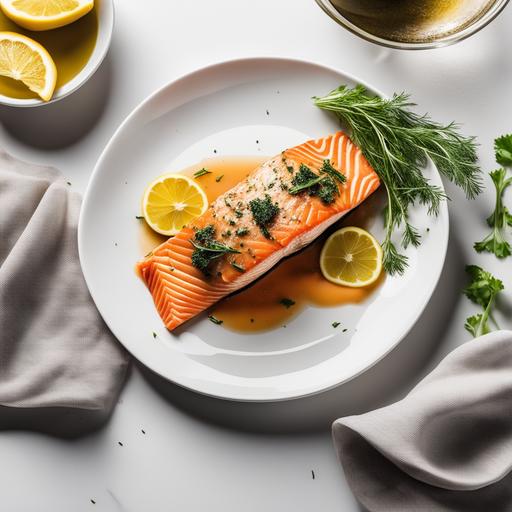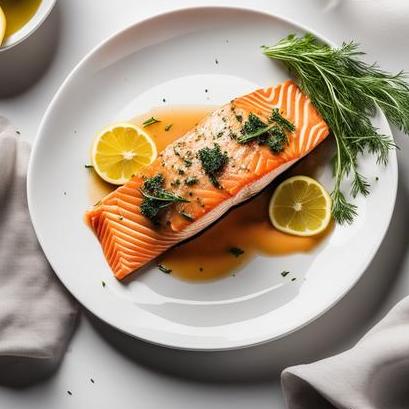
Stuffed Salmon Oven Recipe: A Delightful Culinary Adventure
Salmon, with its rich flavor and delicate texture, is a versatile fish that lends itself perfectly to a myriad of cooking methods. One particularly delightful way to prepare salmon is by stuffing it with a delectable combination of ingredients, and then baking it in the oven to perfection. In this comprehensive article, we will delve into the world of stuffed salmon oven recipes, exploring the food science behind this dish, culinary details, selection guidelines, cleaning tips, step-by-step preparation instructions, helpful variations, tips to ensure the right doneness, and, of course, an irresistible recipe to try yourself!
The Food Science Behind Stuffed Salmon Oven Recipe
To truly appreciate the culinary masterpiece that is the stuffed salmon oven recipe, it is essential to grasp the food science at play. Salmon is an oily fish that contains an abundance of beneficial omega-3 fatty acids. These fatty acids contribute to the fish’s distinctive flavor and moist, tender texture. When properly cooked, salmon delivers a melt-in-your-mouth experience that is both satisfying and nourishing.
By stuffing the salmon, we introduce additional layers of flavor and contrasting textures. The stuffing blends with the natural juices of the salmon, infusing the fish with a delightful medley of tastes that complement each other harmoniously. The heat from the oven works to simultaneously cook the salmon and meld the flavors together, resulting in a dish that is greater than the sum of its parts.
Selecting the Perfect Salmon for Stuffing
When embarking on your stuffed salmon oven adventure, it is crucial to select the right type of salmon for the job. Fresh salmon is always preferred, as it ensures optimal flavor and texture. Here’s what to keep in mind when selecting your salmon:
-
Choose skin-on, boneless fillets: Skin-on fillets help to retain moisture during cooking, while boneless fillets save you the hassle of removing any bones during preparation.
-
Look for vibrant color: Fresh salmon should exhibit vibrant hues of orange or pink, depending on the species. Avoid salmon with dull or discolored flesh, as it may indicate poor quality or excessive aging.
-
Opt for wild-caught salmon: Wild-caught salmon tends to have a more pronounced flavor and a firmer texture compared to farm-raised alternatives.
Cleaning and Preparing the Salmon

Once you’ve selected your salmon, it’s time to roll up your sleeves and prepare it for stuffing. Follow these steps for optimal results:
-
Inspect and rinse the salmon: Examine the fillets for any remaining scales or pin bones. Use tweezers to pluck out any bones you find. Rinse the fillets under cold water to remove any residual scales or impurities.
-
Pat the fillets dry: Gently pat the fillets dry using paper towels. This step is crucial to ensure a crispy skin when baking.
-
Make a lengthwise incision: Using a sharp knife, make a lengthwise incision along the center of each fillet. Be careful not to cut through the other side, as you want to create a pocket for the stuffing.
Crafting the Perfect Stuffing
The stuffing is where you get to exercise your creativity and culinary prowess. Here are some delightful stuffing combinations to consider:
-
Spinach and Feta: Sauté fresh spinach with garlic until wilted, then combine it with crumbled feta cheese for a tangy and earthy stuffing.
-
Crab and Cream Cheese: Mix lump crabmeat with cream cheese, scallions, and a squeeze of lemon juice for a rich and indulgent stuffing.
-
Sun-Dried Tomato and Goat Cheese: Chop up sun-dried tomatoes and mix them with creamy goat cheese for a savory and tangy stuffing option.
Feel free to experiment and create your own unique stuffing combinations. Just ensure that the ingredients you choose complement the flavor profile of the salmon.
Tips for Assembling and Cooking the Stuffed Salmon
To ensure success with your stuffed salmon oven dish, keep the following tips in mind:
-
Stuff with care: Gently spoon the stuffing mixture into the incisions you made in the salmon fillets. Avoid overstuffing, as it can cause the fish to cook unevenly.
-
Secure with toothpicks: Use toothpicks to secure the sides of the salmon fillets together, preventing the stuffing from spilling out during cooking.
-
Preheat the oven: Preheat your oven to 375°F (190°C) to ensure an even and stable cooking temperature.
-
Choose a suitable baking dish: Place the stuffed salmon in a baking dish just large enough to accommodate it comfortably. This helps retain moisture and prevents the stuffing from drying out.
-
Timing is key: Bake the stuffed salmon for approximately 12-15 minutes per inch of thickness. Check for doneness by carefully inserting a fork into the thickest part of the fish. If it flakes easily, without any hint of translucency, it is cooked to perfection.
-
Rest before serving: Allow the stuffed salmon to rest for a couple of minutes before serving. This rest period allows the juices to redistribute throughout the fish, making each bite succulent and flavorful.
Recipe: Irresistible Spinach and Feta Stuffed Salmon

Now that we’ve covered the basics, let’s dive into a specific and mouth-watering stuffed salmon recipe to get you started. Here’s a recipe for Spinach and Feta Stuffed Salmon:
Ingredients:
-
2 salmon fillets (skin-on, boneless)
-
2 cups fresh spinach leaves
-
1 clove garlic, minced
-
1/2 cup crumbled feta cheese
-
Salt and pepper, to taste
-
Olive oil, for sautéing
Instructions:
-
Preheat the oven to 375°F (190°C).
-
Rinse the salmon fillets and pat them dry with paper towels.
-
Make a lengthwise incision along the center of each fillet, creating a pocket for the stuffing.
-
In a skillet over medium heat, sauté the minced garlic in olive oil until fragrant.
-
Add the spinach leaves to the skillet and cook until wilted. Remove from heat.
-
Mix the cooked spinach with the crumbled feta cheese in a bowl.
-
Season the salmon fillets with salt and pepper, then carefully spoon the spinach and feta mixture into the incisions.
-
Close the fillets and secure them with toothpicks.
-
Place the stuffed salmon in a baking dish and bake for approximately 12-15 minutes per inch of thickness, or until the fish flakes easily.
-
Remove the toothpicks, and let the stuffed salmon rest for a few minutes before serving.
Variations and Creative Additions
While the Spinach and Feta Stuffed Salmon recipe is a classic choice, don’t hesitate to explore additional flavor profiles and ingredients. Here are a few variations to inspire your culinary adventures:
-
Mediterranean Delight: Substitute the feta cheese with chopped kalamata olives, sundried tomatoes, and crumbled feta mixed with a hint of lemon zest.
-
Creamy Pesto: Blend together cream cheese, pesto sauce, and pine nuts for a rich and vibrant stuffing.
-
Asian Fusion: Enhance your stuffing with a combination of ginger, garlic, soy sauce, and sesame oil mixed with finely chopped water chestnuts and scallions.
Let your taste buds be your guide, and don’t shy away from experimenting with different ingredients and flavor profiles.
Achieving Perfection: Checking Doneness
To ensure your stuffed salmon reaches the ideal level of doneness, follow these guidelines:
-
Insert a fork into the thickest part of the fish and twist gently. If the flesh flakes easily and is opaque throughout, your salmon is fully cooked.
-
Avoid overcooking, as salmon can quickly become dry and lose its delicate texture.
-
Remember, residual heat will continue to cook the fish even after removing it from the oven. Account for this by removing the salmon from the oven when it is just cooked and will continue to carry-over cook to perfection.
In Conclusion
Embarking on the journey of creating a stuffed salmon oven recipe is an incredible opportunity to unleash your creativity and delight your senses. Through careful selection, precise preparation, and skilled cooking, you can transform a simple piece of salmon into a memorable culinary experience. So go ahead, grab your favorite ingredients, and enjoy the process of crafting a delicious, flavorful, and satisfying stuffed salmon dish that will leave your taste buds dancing with joy. Happy cooking!
Sources
FAQS On Stuffed Salmon Oven Recipe
What Ingredients Do I Need For A Stuffed Salmon Oven Recipe?
To make a delicious stuffed salmon in the oven, you will need the following ingredients: fresh salmon fillets, your choice of stuffing (such as crabmeat, cream cheese, spinach, or even a mixture of herbs and breadcrumbs), garlic powder, salt, black pepper, lemon juice, and olive oil.
How Do I Prepare The Salmon Fillets For Stuffing?
Start by preheating your oven to the desired temperature. Lay the salmon fillets on a clean surface and gently season them with garlic powder, salt, and black pepper to taste. Then, carefully slice open the fillets lengthwise to create a pocket for the stuffing. Be sure not to cut all the way through.
What Are Some Commonly Used Stuffing Options For Salmon?
There is a wide variety of stuffing options that can be used for salmon. Some popular ones include crabmeat and cream cheese mixture, spinach and feta cheese, or even a flavorful blend of herbs, breadcrumbs, and finely chopped veggies. Choose a stuffing that suits your taste preferences and complements the salmon well.
How Do I Stuff The Salmon Fillets?
Take your chosen stuffing mixture and carefully spoon it into the pocket you created in the salmon fillets. Be generous but avoid overstuffing, as that may cause the stuffing to spill out during cooking. Gently press the edges of the salmon together to enclose the stuffing securely.
What Is The Cooking Time And Temperature For Stuffed Salmon In The Oven?
The cooking time and temperature may vary depending on the thickness and size of your salmon fillets. As a general guideline, preheat your oven to 375°F (190°C) and bake the stuffed salmon for approximately 12-15 minutes per inch of thickness. The salmon is cooked when it turns opaque and easily flakes with a fork.


